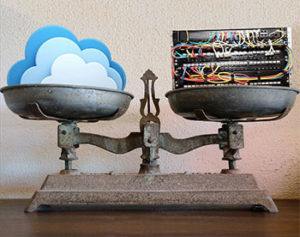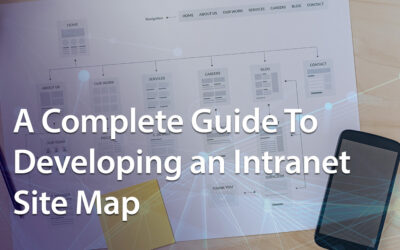Making the decision to go ahead with a company intranet is one of the best business decisions that your organization can make. The next important decision to consider is intranet hosting and which option is the most appropriate for you. In this article, we look at the two basic options and consider the pros and cons of each. The two possibilities are an on-premise server (internal network) versus a cloud-hosted solution (external network). By the time you’ve finished reading this article, you will be able to make an informed choice as to which intranet software solution is the best fit for your company.
On-premise Intranet Software Solution
Opting for an on-premises server solution may seem like a good choice particularly for larger companies that already have a company server on site and a dedicated IT team with the technical know-how. In addition, the possibility of developing a bespoke office intranet that is tailored exactly to the needs of your organization may also be an attractive proposition.
Before going ahead, though, there are some disadvantages that you will need to be aware of. These are examined in detail below and include the following:
- On-premises solutions can be time and resource intensive.
- There will be additional requirements for physical space.
- Flexibility and adaptability can be limited.
- Ongoing security, management and maintenance tasks are your responsibility.
The first disadvantage is that building an intranet from scratch is a major undertaking requiring a significant company investment both in terms of time and resources. Many organizations underestimate what’s involved. Even if you use downloaded software to build the intranet pages, it most likely will require a team of IT professionals or a hired consultant to get the intranet off the ground. What initially looked like a six-month project with a finite budget, can very easily become a protracted process with significant additional costs.
 Another disadvantage is the amount of office space required to house the additional servers and technical personnel necessary for the intranet. Again this requirement is often overlooked or underestimated, and when physical space is at a premium, as it usually is in organizations, this is an important issue.
Another disadvantage is the amount of office space required to house the additional servers and technical personnel necessary for the intranet. Again this requirement is often overlooked or underestimated, and when physical space is at a premium, as it usually is in organizations, this is an important issue.
You will also need to consider what happens if your organization increases in size either organically or through acquisition. Often bespoke intranets are designed with a finite number of users in mind. All works well until the company acquires another operation thereby doubling the number of staff overnight. Alternatively, all can work well until five years down the track when staff numbers have increased considerably as business has been going well. The inherent inflexibility of the on-premises intranet in adapting to changing organizational needs manifests itself in slow CPU speeds, a shortage of storage space and a lack of memory. This will slow down the productivity and efficiency of staff.
Perhaps the most important disadvantage is the responsibility for all ongoing security, management and maintenance issues. With an on-premises solution, you will have the responsibility for ensuring the security of the intranet in terms of virus protection, prevention of hacking as well as the confidentiality of sensitive company information. Keeping abreast of intranet security is almost a full-time job in itself. Added to this are the regular backups and updates that will be required and how this process will be managed without disruption to users or significant downtime.
In short, the on-premises solution can be a viable option for larger organizations with the will and resources to make the significant investment required.
There is, however, another much more accessible and flexible option, especially for small to medium-sized enterprises.
Cloud-Hosted Intranet Software
Under this option, the intranet software is hosted online by an external cloud-based provider for a monthly fee. The cloud-hosted intranet offers templates and features that can be customized to reflect your organization’s brand and set up. The intranet is very easy to install using a step-by-step process that is accessible to even non-technical personnel. And the hosting company retains responsibility for all ongoing security, management and maintenance.
Although ultimately your company intranet is owned by an external company. Therefore, it may feel as though there is a loss of control with this solution, the cloud-hosted intranet has the edge over the on-premises one in a number of critical aspects. These specific advantages are examined in detail below. Demand for SaaS applications like this has continued to increase over the past few years, it is predicted that almost 28% of all enterprise software solutions provided will be cloud based by 2018.
Adaptability and Flexibility
 Cloud solutions like MyHub offer an unlimited user and storage model, so the sky really is the limit, unlike the on-premises solution. Furthermore, this is covered by the same fixed monthly cost, eliminating the unexpected costs factor that can be a weakness of the on-premises model.
Cloud solutions like MyHub offer an unlimited user and storage model, so the sky really is the limit, unlike the on-premises solution. Furthermore, this is covered by the same fixed monthly cost, eliminating the unexpected costs factor that can be a weakness of the on-premises model.
Also, because the intranet is hosted online, it can be accessed by staff anytime and anywhere through an internet connection. This fits in perfectly with the move towards flexible working with staff being able to access important company information at home or on the road.
The cloud intranet really is a flexible solution that adapts to changing business needs.
Security, Management And Maintenance
Cloud solutions offer the very latest in intranet security including secure two-way SSL connections, multiple layers of embedded security, and virus protection. The hosting company is responsible for keeping updated on all security issues so you can be assured that your intranet is as protected as possible.
Furthermore, the hosting company is responsible for updates, backups, monitoring, and alerts. So when it comes to dealing with a 3 am high CPU load alert, it will be the hosting company and not you that will have to manage the response.
Speed And Dependability
The MyHub online platform has high availability and uptime – typically 99.999%. This level of reliability and dependability is a significant advantage over the on-premises version which typically does not have the same speed and consistency of deployment.
In addition, cloud intranets offer the latest technology in global content delivery networks. This technology not only enhances the speed of delivery of your intranet pages, it also delivers intranet pages to a user based on the geographic locations of the user, the origin of the intranet page and a content delivery server. This optimized geographic connectivity for international businesses is a great boon in the globalized economy.
Support
 The hosting company has the knowledge and experience to quickly and easily deal with any queries that might arise. Usually, there is a support team at hand, frequently asked questions or even troubleshooting video tutorials that you can refer to. It is, after all, in the interests of the hosting company for you to get the most out of your intranet solution.
The hosting company has the knowledge and experience to quickly and easily deal with any queries that might arise. Usually, there is a support team at hand, frequently asked questions or even troubleshooting video tutorials that you can refer to. It is, after all, in the interests of the hosting company for you to get the most out of your intranet solution.
The logistical and cost benefits of the hosted solution over the on-premises solution are obvious. Many companies with internal networks find that they have to employ a dedicated technical team to manage and maintain the office intranet as well as providing customer support.
As you can see, the cloud-hosted intranet has all the advantages of the on-premises version without the inherent weaknesses. It offers a cost-effective, flexible and adaptable intranet solution for all businesses.
If the cloud-hosted solution sounds like the right choice for your company, contact us at MyHub for a free consultation on how it can work for you.







0 Comments